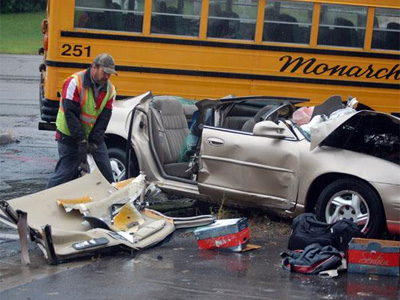
It’s a horrifying moment when news comes that a school bus has been involved in a crash, as one was today in Mendota Heights.
A usual question after a school bus accident is: “Why aren’t there seat belts on school buses?”
The National Association for Pupil Transportation says they aren’t needed:
Because of its superior size and extensive structural and other safety equipment a school bus tends to come out best in most crashes. Instead of seat belts, school buses use a passive approach called “compartmentalization, “well padded, high back, energy absorbing seats. Simply stated, the goal of this approach is to package children like eggs. It has performed extremely well in providing a high level of safety to the many sizes of children who ride school buses, ranging from pre-schoolers up to high school football players riding to games in full gear.
The National Highway Safety Administration says school buses are seven eight times safer than cars or light trucks.
The school bus occupant fatality rate of 0.2 fatalities per 100 million vehicle miles traveled (VMT) is considerably lower than the fatality rates for passenger cars or light trucks (1.44 per 100 million VMT). The relative safety of school buses was addressed in 2002 by the National Academy of Sciences (NAS) in “The Relative Risks of School Travel: A National Perspective and Guidance for Local Community Risk Assessment.”[5] It found that there are about 815 fatalities related to school transportation per year. Only 2 percent are associated with official school transportation, compared to 22 percent due to walking/bicycling to or from school, and 75 percent from
passenger car transportation to or from school.
Which means that if you give your kid a ride to school, he/she is at greater risk than if he/she took the bus.
(MPR Photo/Tom Weber)
